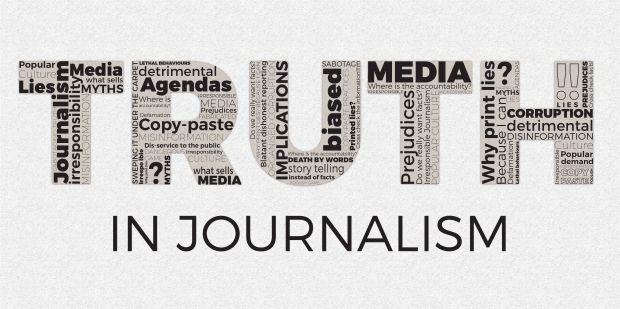How much faith is there in the art of journalism?
Photo Credit: Robert Austin
This graphic makes it coherently clear that while journalism is typically correlated with the word truth, the reality is that there is so much more to the truth then what appears to be.
March 7, 2021
There is no doubt that the “art” of journalism is a historical adumbration that has been prevalent on local, national, and international bases since the beginning of human synergy. With the turn of the twenty-first century, the average person began to spend roughly seven and a half hours per day informing themselves of current events and news through traditional or digital media, according to a study done by statista.com. And with the innovation of social media that is practically ingrained in the daily routine of 3.6 billion people, the global population is finding easier and more convenient ways to stay connected and informed. Because of this, most entrepreneurs and major data analysts assure us that the future of media and journalism is going in the ideal direction. However, recent events and authoritative executives have made it abundantly clear that media and journalism might not be skewed in an affirmative way. Because of this, a true inquisitor might ask oneself, “How much faith is there in the art of journalism?”
All of it comes back to the aphorism that parents nurture their children with when giving advice about life: “Don’t believe everything you read.” That seems uncomplicated in theory, but in reality, it’s vastly complicated. With the bombardment of many media informants telling the same story in a vastly different diction and tone, which enunciates the prime difference between CNN and Fox News, it’s very easy to ponder whether the information you are getting is “accurate” or “reliable”.
With the advent of artificial intelligence and the ability to create pieces of writing from baseless details, it is hard to decipher the “fake news” from the “real news”. An experiment done by brookings.edu, headed by Darrell M. West and John R. Allen, presented people with articles, one fake and the rest real and the participants had to decide which one was the fake article. A high percentage of people have reported that the fake one was actually a real article, or they could even decide which one was the fake article because they all seemed real and legitimate. This is undoubtedly scary and dangerous. If random people can be hoodwinked so easily in an experimental setting, imagine how hoodwinked the average person can be in the real world. But it’s not just artificial intelligence that can contain the power to trick humans.
In 2003, the eminent movie documentary, “Shattered Glass”, was released for public viewing. The film depicted one of the gravest scandals in the history of journalism. In the 1990s, a man named Stephen Glass was a reporter and writer for the New Republic Magazine: “the in-flight magazine of Air Force One”. He was known on the roundtable for his dexterity at getting leads on such dramatic and sensationalistic topics. But little did his co-workers and his bosses know, it was all made up! After a nearby magazine challenged the validity of one of Glass’s articles, an inside investigation by his own boss, Chuck Lane, took place. After a while, Lane discovered that not only was the one article fabricated, but Glass had been fabricating articles for almost half of his career. For years, the New Republic had published and printed articles by Glass claiming them to be fact, when really, they were all fiction. Glass was terminated, and the New Republic lost much of its credibility from that time on.
To reiterate my claim, how can an average person know that the information they are receiving is completely accurate and one-hundred percent reliable? If professional editors, copywriters, and journalists couldn’t catch Glass’s debunked articles as false, what faith is there that the average person can? Unfortunately, there really is no faith. People like Glass and artificial intelligent geniuses have found a way to hinder the very pillar of journalism and the very attribute that maintains its faith: truth. A just society is one that is based on a coherent and transparent truth and that is the job of the journalist.
From its beginning, the intention of journalism was to always keep people informed to better their sense of reality and limit their stress, while also, always uncover the rightful truth. The First Amendment of the Constitution guarantees the right for journalists to proceed with this agenda, while not facing any laws derailing it. But, let’s face it, the First Amendment was created a long time ago – we are in a different world today. Now, modern society tends to denote news sources by using political bynames like “liberal” and “conservative” to add flavor to the biased tone they generate. But these names have certainly taken a toll on the validity of political journalism. Instead of becoming a safeguard source, the media has been deemed a corrupt bargain.
“It only takes one person to make a difference”. You have probably heard this deprecating cliche before; however, you have probably heard it with a positive emphasis. But for a sense of maintaining cohesion, it is best to attribute it to a negative tone. Stephen Glass was just one person, yet it was only him who cost the reputation of the New Republic Magazine. Artificial intelligence is just one piece of software, yet it was only that piece of software that deceived almost all the participants of the hitherto experiments. Corrupt journalism doesn’t have to be maintained through every person within the media network, it only takes one to rewrite the story.
Journalism, as it has been aforementioned, endeavors to keep people informed. All types of people, regardless of their status, political affiliation, or even gender. But instead, it has recently been abused as a source of weaponry. Journalism has the power to shift the narrative, thereby shifting the point of view and opinions of the masses. It can be used to denounce a political candidate or shy away from an oppressing story that demands attention yet goes against the bias of the network. Therefore, it is a weapon. One of the most powerful weapons, no doubt, in the modern era. Many examples, just in the past year point to this indication. We have lost most faith in regards to journalism being called “accurate” and “reliable”. It has the ability to grant people, or just one person, so much power that they begin to misuse it as a weapon against others rather than a unifying symbol for us all.
But, are weapons always considered “bad”? Without guns, heavy artillery, or even poisonous gas, many past wars would have certainly yielded different outcomes. Weapons, though they have the power to harm and wound, can save us.
In 2019, HBOMax released a film called “Bad Education”. It recounts the scandalous activity within the Roslyn Union Free School District in 2002. Frank Tussone, superintendent of the district, and his assistant, Pam Gluklin, are credited with bringing the district unprecedented prestige. Frank was a master of positive messaging, whether before an audience of community leaders or in an office with a concerned student or parent. Like Glass, it was hard to fathom the fact that Tussone and Gluklin would ever find themselves at the vanguard of an embezzlement scheme the likes of which no one had ever seen before. But how did the public find out about this illicitness? Tussone and Gluklin certainly never presented any sides of furtive pilfering and no one was ever suspicious of them doing any sort of wrongdoing. The answer is that a Roslyn high school student journalist, named Rachel Bhargava, refused to give up the search for the truth!
Nellie Bly once said: “I said, I could, I would, and then I did,”. This quote simply paraphrases her own life. Bly was a pioneer in ushering in a new era of writing known investigative journalism, though she lived and worked at a time where yellow journalism plagued the nation. In places across the world, she would put herself in danger for the hard, unearthed truth. And she did it at a time where women were expected to do nothing but to stay home and care for the household and children. But it was her perseverance and defiance that led her to change society for the better and to change journalism forever. The epitome of Bly was within Bhargava when she delved into past school records and accounts, defied the word and advice of her editors, and struggled with a formidable moral dilemma – all to search for the rightful truth.
If used properly and with appropriate reasons and justifiable exigence – journalism can and has the ability to do great things. Like Bly and Bharagava have shown, true investigative journalism isn’t easy and backlash will be coming at you the whole way. Many journalists have dealt with this debacle: “Do I search for the truth that will better the majority, even if it will destroy the lives of the minority?” When it comes to the search for the truth that will reestablish society for the better, rid the world of corruption, and refuel the faith – then the road to pick is a no-brainer.
The art of journalistic writing can never be taken for granted. No matter where we go as a civilization, people must continue to use journalism to the better truth, not abuse it as a weapon for societal gain. People must learn from the stories of Glass and Tussone, who underestimated the power of investigative journalism and its long-lasting, forever ingrained effects. People must continue to revitalize and retell the stories of Bly and Bhargava to show what true resilience and devotion looks like in the eyes of an unjust society. And finally, people must always remember and recall that journalism is a unifying force, not a dividing one. The question can not be whether journalism still has any faith left, but whether our society is worth abiding by these regulations and principles for the foreseeable future. Only then will journalism remain faithful and its essence will be restored.




